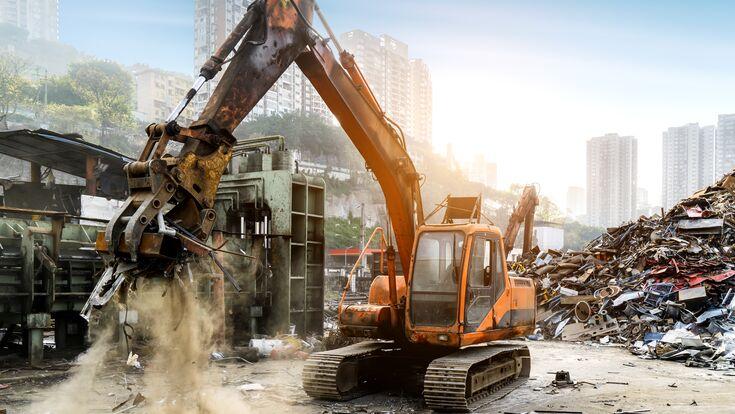Different types of waste comprise C&D materials. These are produced while roads, bridges, and structures are being built, renovated, or demolished.
Certain C&D resources are classified as commodities under the Sustainable Materials Management system that the EPA advocates. The requirement to extract and deal with new resources can be avoided. These can be used in future structure projects.
Construction and Demolition Materials
These are produced during the construction of building structures and collected by Sways Junk Removal & Demolition llc, for instance. Additionally, during the renovation or demolition of existing buildings. Public works projects including roadways, highways, bridges, utility facilities, piers, and dams are examples of engineering structures.
These resources frequently include large, weighty materials. This covers bricks, rocks, concrete, asphalt, gypsum, metals, glass, wood, and polymers. Trees and repurposed building resources are also incorporated.
Benefits of Reducing C&D Junk
The following are some of the main advantages of trash reduction, reuse, and recycling.
- In the recycling industry, it generates revenue and jobs. It offers more chances for local companies to do business. Particularly when methods of selective demolition and reconstruction are applied.
- Lower the total cost of the building project by avoiding acquisition or disposal expenses. The tax-beneficial donation to designated charities. Reusing on-site lowers transportation expenses as well.
- There will be fewer disposal sites, which could lessen the related environmental problems.
- Balancing the damage that new resources and usage do to our surroundings.
- Keep landfill space in check.
What can you do with this Construction and Demolition waste?
Materials of many different kinds can be found in C&D trash. There are numerous approaches to recycling. These recovered goods can also be used in a variety of markets.
Still, the majority of C&D recycling procedures start the same. Construction and Demolition products are used to sort waste. To facilitate separation, the junk may occasionally be ground or crushed.
- Reducing
Source reduction lowers the amount of energy, supplies, and waste produced during a life cycle. It’s the top priority for the EPA when it comes to solid waste problems – read https://mde.maryland.gov/programs/land/solidwaste/pages/index.aspx for more info. They have the following measures:
- Maximizing space and creating flexible architecture in new structure to extend its lifespan.
- Include purchase agreements that stop extra packing and materials from getting to the building site.
- Utilizing building techniques that enable resource reuse and deconstruction.
- Lowering interior finishes and using different framing methods.
- Salvaging
It involves taking structures apart meticulously to save parts that can be recycled or used again. It can be utilized in several ways to recover recyclable supplies and drastically reduce waste. Benefits include the following:
- Increases the amount of supplies recovered.
- Preserves the limited resources of old-growth forests.
- Offers a large number of work and training options.
- Enables localities to develop their businesses when combined with conventional demolition techniques.
- Shift junk that’s scheduled for removal.
- Reuses materials to preserve them.
- Reusing
The reduction in the manufacturing of new supplies results in the avoidance of resource and energy use. Frequently utilized C&D components and applications comprise:
- Some objects are simple to eliminate, such as fixtures, doors, hardware, and appliances. These can be saved for donation, to be used in the reconstruction process, or for other purposes.
- To avoid cutting the entire length of lumber, wood cutoffs can be used for blocking, lintels, and cripples. On the job chipping of scrap wood allows it to be used as ground covering or mulch.
- In moderation, de-papered and ground gypsum can be applied as a fertilizer.
- On-site reprocessing is possible for masonry, concrete, and brick for use as pavement, filler, and subbase material.
- You can use extra insulation from outer walls to reduce noise inside.
- Some paint can be reused as a primer layer for other projects or storage places.
- Recycling
A lot of structure supplies can be recycled in areas where there are outlets. Rubble, concrete, and asphalt are frequently recycled to create new goods like aggregate or concrete. Wood can be repurposed to make furniture and other engineered wooden items.
Steel, brass, and copper are among the important supplies that can be recycled. Supplies that are sent for recycling can occasionally be improperly or badly handled.
Posing a few queries to your recycler, such as if they abide by local and state laws. It’s important to possess a state license or registration, as well as third-party validation. This can guarantee that your supplies are managed appropriately and as intended – go here to learn more.
- Rebuying
Purchasing recycled content items and used C&D components for use in new building projects can:
- Since salvaged materials are usually found locally, support the local economy.
- Reduce structure-function or performance costs during structure and refurbishment.
- Make sure the resources gathered from recycling and reuse initiatives are put to another use. They ought to be involved in the production of new goods and/or building projects. Thereby appreciating the full advantages of recycling and reuse.
- In certain situations, preserve the historic relevance and architectural character of that region.

Comments